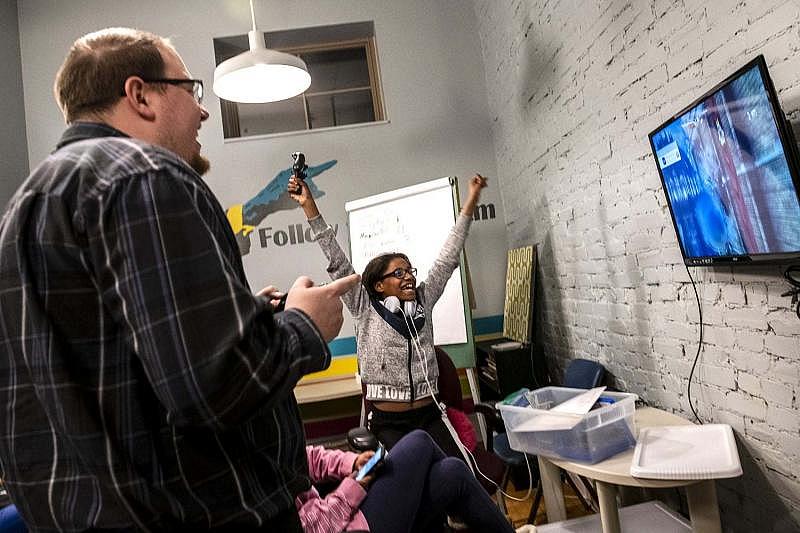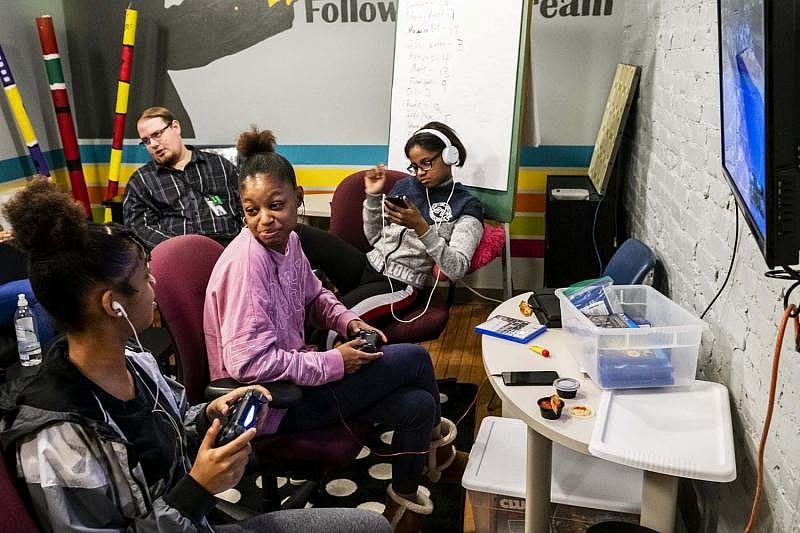Where fighting poverty is a priority
This story was produced as part of a larger project led by Rich Lord, a participant in the USC Center for Health Journalism's 2018 Data Fellowship.
Other stories in this series include:
Charges lodged in North Braddock arrest
Growing up through the cracks: The children at the center of North Braddock's storm
Growing up through the cracks: Policing change brings cops up close with kids in poverty
Pittsburgh's neighborhood boosters face changing landscape
Current and former Rankin residents remember the past, envision the future
Rankin, Pennsylvania: Fighting 'the depressed mindset'
Growing Up Through the Cracks: Mapping Inequality in Allegheny County
A mother moves from McKeesport to Glassport to try to better her family’s chances
Growing up through the cracks: North Braddock: Treasures Amid Ruins

“I buy shoes because I just want to feel youthful. I didn’t really have a childhood, I was too busy helping to raise a household,” says Mark Pence as he browses for shoes Thursday, Jan 24, 2019, in Louisville.
By Christopher Huffaker and Michael M. Santiago
Mark Pence, 25, went to seven high schools before earning his diploma, between stints in juvenile detention and mental hospitals. When he was 8 years old, he stabbed a classmate. He spent part of his childhood living in his mother’s car, and saw his father go to prison when he was a teenager. In 2010, while in detention, he told his mother he was ready to drop out of high school, he said.
He decided to make one last attempt, and he registered at Liberty High School, in Louisville, Ky., an alternative school for underperforming students, where he began visiting the school’s Family Resource Center nearly every day. “Liberty for me was really what saved my life,” said Mr. Pence.
Today, he has college credits and a job — in part, he believes, because of the help available in his hometown.
Those school-based social service centers, affectionately known as “friskies,” for Family Resource and Youth Services Centers of KY (FRYSCKy), are one of many examples of unified services in the Louisville area — a stark contrast to the fragmented structure of southwestern Pennsylvania — enabled by a city-county government, a unified school district, and a concerted push by local leadership to address social issues head-on.
The Pittsburgh Post-Gazette series Growing up through the Cracks, launched in January, is exploring how our region’s fragmented government contributes to the persistence of pockets of very high child poverty, including a dozen communities of size in which half of all kids are growing up in impoverished households. Louisville, with one metro government and two school districts, stands in stark contrast.
Some say the centers, the governmental unity and a “compassion agenda” are among the reasons Louisville has seen its child poverty rate drop over 10 percent since 2012; 22 percent of the city’s children were in poverty in 2017. Allegheny County began that period with a lower rate of child poverty, around 17 percent, but has made no progress. Nationwide, the child poverty rate dropped two percent from 2012 to 2017.
For Mr. Pence, the improving conditions for Louisville’s youth have been more than statistical. The FRYSCKy at his school, he said, showed him a way out. “I’d go there and get clothes, food, bus tickets. They’d invite me to stuff like counselling,” said Mr. Pence.
Kentucky’s Family Resource Centers put state employees in low-income schools, where they connect families to public programs and offer winter clothing, school supplies, and food to take home over the weekend.
The FRYSCKy counsellor “really took me under her wing, and made sure I got to college. She made sure the fees, SATs, everything got taken care of. She helped get my financial aid done,” said Mr. Pence.
Amauri Ray, left, 3, gets a haircut from his godfather Mark Pence, Wednesday, Feb. 13, 2019, in Louisville, Ky.
Tom Speed, left, meets weekly with Mark Pence ,25, to mentor Pence, who has experienced chronic homelessness throughout his life, Monday, Feb. 11, 2019, in Louisville, Ky.
Mr. Pence has hit further bumps in the road, dropping out of his initial college, Kentucky State, and ending up in legal trouble again, before enrolling at Spalding University, a private Catholic University, in 2017, from which he plans to graduate. But there’s always been help to to keep his head above water. After spending time homeless, he joined the Youth Action Board of Louisville’s Coalition for the Homeless, which helped him find housing. The coalition coordinates efforts to address homelessness between nonprofits, the Louisville government and the federal government. He spent time at the YMCA “Safe Place”, a youth shelter, and went to local churches for help with rent and food.
According to Mr. Pence, the self–proclaimed Compassionate City has saved his life a second time. “I wouldn’t be here talking to you without it,” said Mr. Pence.
Unified government
Some major factors in Louisville’s recent success are out of local hands. The economic recovery after the 2008 recession increased employment, and the expansion of Medicaid under Obamacare was strongly felt in Kentucky; 400,000 residents, almost 10% of the state, enrolled.
But many causes of the decline in child poverty, which is pronounced compared to peer cities, are local. Louisville’s consolidated government is a decade and a half old now, and it’s allowed for coordinated decision-making in a way that was not possible before.
Laneyia Keating, left, gets words of encouragement from Leighanna Thompson of Louisville during Volunteers of America’s Study Buddy program, Thursday, Jan. 24, 2019, at Transitional Housing Program & Emergency Family Shelter in Louisville, Ky.
In 2003, the city of Louisville and surrounding Jefferson County merged into one Metro Louisville. Over 80 municipalities were combined, although some cities retain some independent services. Three decades earlier, in 1975, courts forced a school district merger to prevent segregation. Today, Jefferson County Public Schools covers nearly the entire county, excepting only the tiny Anchorage Independent Schools. That compares to 43 districts and 130 municipalities in Allegheny County.
By one measure developed at the University of Pittsburgh Graduate School of Public and International Affairs, Louisville is one of the large metro areas that spreads public funds among the fewest governments, while the Pittsburgh region is one of the nation’s three most fragmented (along with the Chicago and New York City metro areas).
“You are wasting all this money, all these resources,” with more municipalities, said Mary Ellen Wiederwohl, the chief executive of Louisville Forward, the agency responsible for community and economic development.
“We merged our housing authority, which is an important thing to do,” said Cathy Hinko, director of the Metropolitan Housing Coalition, a affordable housing advocacy group. Allegheny County has three housing authorities: Pittsburgh, McKeesport and Allegheny County.
Unified control has allowed Louisville to impose limitations on tax incentives to companies. “We will only offer the largest tax incentives for [companies that pay workers] $18 per hour and benefits,” or sometimes, for those that locate in and hire from distressed neighborhoods, said Ms. Wiederwohl.
Danielle Washington, right, attends Volunteers of America’s Teens with a Purpose program, which gives teen living in the transitional housing and emergency family shelter, a space to interact with each other and volunteers including Greg Hummel, left.
One success story is the under-construction new headquarters for Passport, a non-profit healthcare provider, in West Louisville, the city’s historic poor, black area. Nearby, the Louisville Urban League is building a large sports complex with city funding.
According to advocates, having a single pressure point is hugely valuable.
”At every council meeting for two years, organizations worked together to always have three people talk about housing,” said Ms. Hinko. That resulted in Metro Louisville spending $41 million on its Affordable Housing Trust Fund over the last three years, funding over 2,000 units.
“It worked because we have a unified government,” she added.
The compassionate city
“Ilost everything when I had her,” said Heather Glidewell, 19, of her daughter Khloe Lane, 2. When she became pregnant, she was kicked out of her parents house and her private Christian high school, Ms. Glidewell said.
She turned to Family Scholar House, a Louisville nonprofit, that provides subsidized housing, support services including financial and academic advising, and necessities like food and furniture to single parents in higher education.
Destiny Clark, left, 22, prepares to cook breakfast for her son Tevin Webster, 4, Friday, Jan. 25, 2019, at the newly built Family Scholar House campus in Louisville, Ky.
“Family Scholar House basically saved me and her. I don’t think I’d be in college now without them.”
“I didn’t have anything but clothes,” said Ms. Glidewell.
Family Scholar House is one of the many nonprofits that have flourished in Louisville in the last decade, as part of the “Compassionate City” agenda announced by Mayor Greg Fischer in 2011, his first year in office.
Southwestern Pennsylvania has a strong philanthropic sector as well — in fact, the Family Scholar House is in talks with some Pittsburgh foundations about replicating their model here. But Louisville explicitly adopting a “Compassionate City” agenda has provided a boost, locals say.
“We’re seeing a nonprofit boom serving different people: single mothers, people reentering from the justice system, veterans, black people,” said Mr. Pence.
The Family Scholar House, which funds its programming through grants, is dependent on that nonprofit largesse. Its housing is paid for with federal money, but for its services, it has “no continuous source of funding,” said CEO Cathe Dykstra.
City and foundation money has allowed the program to grow from four participants in 2005 to over 200 resident families now, said Ms. Dykstra.
Residents are required to be enrolled in higher education, including apprenticeship programs, and about 86% leave with a degree, she said.
Residents said the Family Scholar House has kept them in school. Jasamin Johnson, 25, and her daughter Taylor Norfleet, 3, have lived at the Family Scholar House since Taylor was three weeks old.
“I was out on my own at the age of 16, but still graduated high school in the top 10%. I went straight to college,” she said.
But when she became pregnant, “School was not in the picture at all.”
By completing community engagement sessions and classes while pregnant, Jasamin Johnson, 25, was able to move into Family Scholar House three weeks after her daughter Taylor Norfleet, now 3, was born.
Now, she works full time as a benefits manager and is on the Dean’s List at Indiana Tech, a Fort Wayne-based non-profit university with online programs.
Destiny Clark, 22, said that living at Family Scholar House has allowed her to build a better life for her son, Tevin Webster, 4.
“I’m paving a new path for him,” she said. Ms. Clark studies biology at Ivy Tech Community College of Indiana and plans to transfer to the University of Louisville to complete her bachelor’s degree.
Other anti-poverty programs that have grown since the Compassionate City was launched are less comprehensive, but fill vital gaps.
Sisters from left, Diana Washington, De’aija Washington and Danielle Washington attend Volunteers of America’s Teens with a Purpose program, Thursday, Jan. 24, 2019.
Nancy Damartia, who convenes a weekly “Poverty Study Group” in West Louisville, pointed to churches and organizations that provide food assistance, particularly Blessings in a Backpack, a program that sends children home from school with food on weekends. Terry Brooks, director of Kentucky Youth Advocates, praised the local branch of “Volunteers of America,” a national group which works in affordable housing and family support.
“Louisville nonprofits for whatever reason seem especially attuned to very pragmatic, focussed anti-poverty supports,” said Mr. Brooks.
Room for progress
In 2008, Pittsburgh Mayor Luke Ravenstahl and Allegheny County Executive Dan Onorato lined up behind a plan, partially inspired by Louisville, to merge the city and county governments. Lacking broader support, the plan went nowhere.
But that doesn’t mean working together is impossible, according to University of Pittsburgh policy professor David Y. Miller, who in 2009 founded the Congress of Neighboring Communities (CONNECT), to bring together Allegheny County municipalities .
“We’ve made the political decision that we have a lot of governments,” he said. “So we have to be better than everyone else at working across those borders.”
Allegheny County Rich Fitzgerald declined to comment for this article, but he told the Post-Gazette in December that his strong relationship with Mayor Bill Peduto is unusual. “The mayor and the Allegheny County Executive working together has never really happened before.”
At the same time, for all the progress, there’s much more to be done in Louisville as well: More than one in five kids is still in poverty.
Even the state-funded FRYSCKys are unable to keep up with demand, according to Ben Reno-Weber of the Greater Louisville Project, another advocacy group.
“The power of a FRYSCKy in theory is that they can leverage multiple types of resources. The problem of a FRYSCKy is they’re too overwhelmed to do that,” he said.
Access to new jobs is another issue, said Natalie Harris, director of the Coalition for the Homeless. “Transportation is a huge issue. UPS & Amazon came in, set up on the edge of town, and then said they needed a bus route.”
Amauri Ray, 3, left, and his godfather Mark Pence smile as they check out Amauri’s new haircut in a mirror, Wednesday, Feb. 13, 2019, in Louisville, Ky.
Ms. Williams laments the lack of dedicated funding source for the Affordable Housing Trust Fund, which is currently funded out of Metro Louisville’s annual budget process.
And most government housing programs do little to counter the concentration of poverty. “Voucher people all end up in the same poor neighborhoods,” said Ms. Harris, because those are the only places the federal Section 8 vouchers can pay the rent.
“If the way we disperse child poverty is to put these kids on ice floes on the Ohio river, I won’t consider that a success,” said Ms. Hinko.
But consolidation makes bigger actions possible, she said. “Merged government offers a better opportunity.”
[This story was originally published by Pittsburgh Post-Gazette.]

